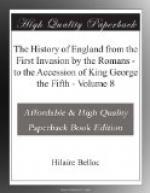The lord lieutenant, however, found that he was supported by some of the prelates, and by most of the aristocracy. He replied[d] to the synod at James-town, that nothing short of necessity should induce him to quit Ireland without the order of the king; and the commissioners of trust expostulated[e] with the bishops on their imprudence and presumption. But at this moment arrived copies of the declaration which Charles had been compelled to publish at Dunfermling, in Scotland. The whole population was in a ferment. Their suspicions, they exclaimed, were now verified;
[Footnote 1: Ponce, Vindiciae Eversae, 236-257. Clarendon, viii. 151, 154, 156. Hibernia Dominicana, 691. Carte, ii. 118, 120, 123.]
[Sidenote a: A.D. 1650. August 10.] [Sidenote b: A.D. 1650. August 11.] [Sidenote c: A.D. 1650. August 12.] [Sidenote d: A.D. 1650. August 31.] [Sidenote e: A.D. 1650. Sept. 2.]
their fears and predictions accomplished. The king had pronounced them a race of “bloody rebels;” he had disowned them for his subjects, he had anulled the articles of pacification, and had declared[a] to the whole world that he would exterminate their religion. In this excited temper of mind, the committee appointed by the bishops published both the declaration and the excommunication. A single night intervened; their passions had leisure to cool; they repented[b] of their precipitancy; and, by the advice of the prelates in the town of Galway, they published a third paper, suspending the effect of the other two.
Ormond’s first expedient was to pronounce the Dunfermling declaration a forgery; for the king from Breda, previously to his voyage to Scotland, had solemnly assured him that he would never, for any earthly consideration, violate the pacification. A second message[c] informed him that it was genuine, but ought to be considered of no force, as far as it concerned Ireland, because it had been issued without the advice of the Irish privy council.[1] This communication encouraged




